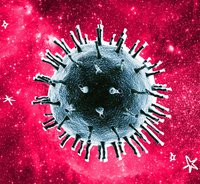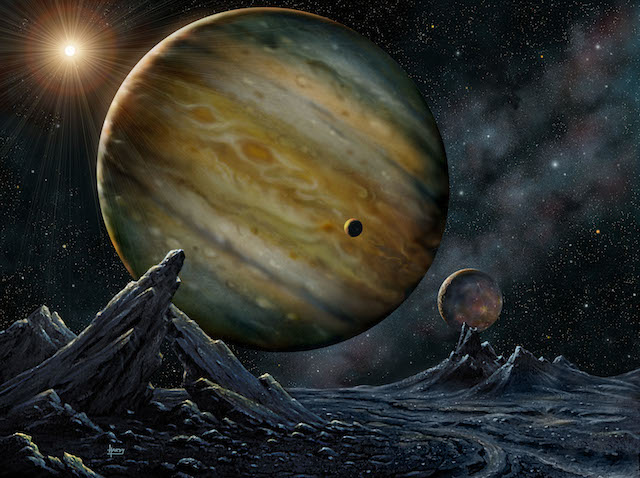
Thank you for your interest in Astrovirology, please take a minute to fill out a survey to improve future virtual workshops.
https://forms.gle/xMe7JXjDhwyqjkFJ7
Dates: Wed, Sept 18 8:00AM – 12:00PM PDT and Thurs, Sept 19 1:00PM – 5:00PM PDT
The National Aeronautics and Space Administration (NASA) Astrobiology Institute (NAI) is hosting a virtual Workshop Without Walls on Astrovirology to review and advance the science of understanding what a virus is, their origin, ecology, impact on evolution, and their role in exobiology as a biosignature.
This virtual workshop will be over two half-days to enabled global scientific exchange with no attendance costs or travel required. Topics covered will presented in a manner to reach a range of scientific understanding including students, researchers, educators, science writers, and members of the general public.
This virtual workshop will consist of presentations and time for questions or discussion periods, facilitated through an online multi-user video-conferencing system hosted by the technical facilities of the NAI.
Science Organizing Committee:
Gareth (Gary) Trubl, Lawrence Livermore National Lab, Trubl1@llnl.gov
Kathryn Bywaters, NASA Ames/SETI, kathryn.f.bywaters@nasa.gov
Kenneth Stedman, Portland State University, kstedman@pdx.edu
Penelope Boston, NASA Ames, penelope.j.boston@nasa.gov
Schedule: (talk length/time for questions)
Day 1 – Wednesday, September 18, 2019, 8:00AM – 12:00PM PDT
Theme: Origins and Evolution
8:00–8:30 | Welcome and Introductions | Penny Boston, Ken Stedman | 30/0
8:30–9:00 | Detecting Life Universally (in Water) | Steven Benner (Foundation For Applied Molecular Evolution, USA; sbenner@ffame.org) | 20/10
9:00–9:30 | Small Circular DNA Viruses: The muddy “playground” of recombinant, reassortant, and highly diverse viruses | Arvind Varsani (Arizona State University, USA; Arvind.Varsani@asu.edu) | 20/10
9:30–10:00 | Viruses never do as they’re told, and there’s a good reason for it: bacteria-phage coevolution as a driver of diversity | Britt Koskella (University of California Berkeley, USA; bkoskella@berkeley.edu) | 20/10
10:00–10:30 | Viral symbiosis: New rules for pre-cellular evolutionary tempo and mode | Rachel Whitaker (University of Illinois Urbana-Champaign, USA; rwhitaker@life.illinois.edu) | 20/10
10:30–10:40 | Break
10:40–11:10 | Viral infection modes and invasion fitness across a continuum from lysis to latency | Joshua Weitz (Georgia Institute of Technology, USA; jsweitz@gatech.edu) | 20/10
11:10–11:40 | Possibilities and pitfalls of expanded host range mutations | Siobain Duffy (Rutgers University, USA; duffy@sebs.rutgers.edu) | 20/10
11:40–12:00 | Closing remarks | Ken Stedman | 10/10
Day 2 – Thursday, September 19, 2019, 1:00PM – 5:00PM PDT
Theme: Ecology and Exobiology
1:00–1:10 | Opening remarks | Ken Stedman | 10/0
1:10–1:50 | Virus taxonomy: What is it and why should I care? | Evelien Adriaenssens (Quadram Institute Bioscience, UK; evelien.adriaenssens@quadram.ac.uk) | 30/10
1:50–2:20 | Astrovirology in marine systems: how virus-microbe interactions accelerate evolution and generate organismal diversity | Nigel Goldenfeld (University of Illinois Urbana-Champaign, USA; nigel@illinois.edu) | 20/10
2:20–3:00 | Viral ecogenomics: exploring viral diversity and virus-host interactions from metagenomes | Simon Roux (Joint Genome Institute, USA; sroux@lbl.gov) | 30/10
3:00–3:30 | Life detection and viruses as biosignatures | Kathryn Bywaters (NASA Ames/SETI, USA; kathryn.f.bywaters@nasa.gov) | 20/10
3:30–3:40 | Break
3:40–4:10 | Using stable isotopes to track viruses in soils | Gary Trubl (Lawrence Livermore National Lab USA; Trubl1@llnl.gov) | 20/10
4:10–4:40 | Astrovirology – What’s missing? | Ken Stedman (Portland State University, USA; kstedman@pdx.edu) | 20/10
4:40–5:00 | Acknowledgements | Penny Boston, Ken Stedman, Gary Trubl, Kathy Bywaters | 15/5
Workshop Resources:
What is Astrobiology
Astrobiology at NASA
NASA Astrobiology Institute
Ask an Astrobiologist Homepage
The History of Astrobiology
The Astrobiology Primer
Bacteriophage
ViralZone
Previous NASA Astrobiology Roadmap.
Suggested articles:
Pett-Ridge, J. and Firestone, M.K., 2017. Using stable isotopes to explore root-microbe-mineral interactions in soil. Rhizosphere, 3, pp.244-253. [https://www.sciencedirect.com/science/article/pii/S2452219817300691]
Musat, N., Musat, F., Weber, P.K. and Pett-Ridge, J., 2016. Tracking microbial interactions with NanoSIMS. Current opinion in biotechnology, 41, pp.114-121. [https://www.sciencedirect.com/science/article/abs/pii/S0958166916301574]
Blazewicz, S.J., Schwartz, E. and Firestone, M.K., 2014. Growth and death of bacteria and fungi underlie rainfall‐induced carbon dioxide pulses from seasonally dried soil. Ecology, 95(5), pp.1162-1172. [https://esajournals.onlinelibrary.wiley.com/doi/full/10.1890/13-1031.1]
Blazewicz, S.J. and Schwartz, E., 2011. Dynamics of 18 O incorporation from H 2 18 O into soil microbial DNA. Microbial ecology, 61(4), pp.911-916. [https://link.springer.com/article/10.1007/s00248-011-9826-7]
Pacton, M., Wacey, D., Corinaldesi, C., Tangherlini, M., Kilburn, M.R., Gorin, G.E., Danovaro, R. and Vasconcelos, C., 2014. Viruses as new agents of organomineralization in the geological record. Nature communications, 5, p.4298. [https://www.nature.com/articles/ncomms5298]
Trubl G, Roux S, Solonenko N, Li Y, Bolduc B, Rodríguez-Ramos J, Eloe-Fadrosh EA, Rich VI, Sullivan MB. 2019. Towards optimized viral metagenomes for double-stranded and single-stranded DNA viruses from challenging soils. PeerJ 7:e7265 [https://doi.org/10.7717/peerj.7265]
Roux S, Trubl G, Goudeau D, Nath N, Couradeau E, Ahlgren NA, Zhan Y, Marsan D, Chen F, Fuhrman JA, Northen TR, Sullivan MB, Rich VI, Malmstrom RR, Eloe-Fadrosh EA. 2019. Optimizing de novo genome assembly from PCR-amplified metagenomes. PeerJ 7:e6902 [https://doi.org/10.7717/peerj.6902]
Horlacher, J., Hottiger, M., Podust, V.N., Hübscher, U. and Benner, S.A., 1995. Recognition by viral and cellular DNA polymerases of nucleosides bearing bases with nonstandard hydrogen bonding patterns. Proceedings of the National Academy of Sciences, 92(14), pp.6329-6333. [https://www.pnas.org/content/92/14/6329.short]
Warwick-Dugdale, J., Solonenko, N., Moore, K., Chittick, L., Gregory, A.C., Allen, M.J., Sullivan, M.B. and Temperton, B., 2019. Long-read viral metagenomics captures abundant and microdiverse viral populations and their niche-defining genomic islands. PeerJ, 7, p.e6800. [https://peerj.com/articles/6800]
Wongsurawat, T., Jenjaroenpun, P., Taylor, M., Lee, J., Tolardo, A.L., Parvathareddy, J., Kandel, S., Wadley, T.D., Kaewnapan, B., Athipanyasilp, N. and Skidmore, A., 2019. Rapid sequencing of multiple RNA viruses in their native form. Frontiers in microbiology, 10, p.260. [https://www.frontiersin.org/articles/10.3389/fmicb.2019.00260/full]
Boldogkői, Z., Moldován, N., Balázs, Z., Snyder, M. and Tombácz, D., 2019. Long-read sequencing–a powerful tool in viral transcriptome research. Trends in microbiology. [https://www.cell.com/trends/microbiology/fulltext/S0966-842×(19)30036-8]
Benner, S.A., 2017. Detecting Darwinism from molecules in the Enceladus plumes, Jupiter’s moons, and other planetary water lagoons. Astrobiology, 17(9), pp.840-851.
[https://www.liebertpub.com/doi/full/10.1089/ast.2016.1611?url_ver=Z39.88-2003&rfr_id=ori:rid:crossref.org&rfr_dat=cr_pub%3dpubmed]
Berliner, A.J., Mochizuki, T. and Stedman, K.M., 2018. Astrovirology: Viruses at large in the universe. Astrobiology, 18(2), pp.207-223.
[https://www.liebertpub.com/doi/abs/10.1089/ast.2017.1649]
Zhao, L., Seth-Pasricha, M., Stemate, D., Crespo-Bellido, A., Gagnon, J., Draghi, J. and Duffy, S., 2019. Existing host range mutations constrain further emergence of RNA viruses. Journal of virology, 93(4), pp.e01385-18.
[https://jvi.asm.org/content/93/4/e01385-18/article-info]
Roux, S., Adriaenssens, E.M., Dutilh, B.E., Koonin, E.V., Kropinski, A.M., Krupovic, M., Kuhn, J.H., Lavigne, R., Brister, J.R., Varsani, A. and Amid, C., 2019. Minimum information about an uncultivated virus genome (MIUViG). Nature biotechnology, 37(1), p.29.
[https://www.nature.com/articles/nbt.4306]
Kazlauskas, D., Varsani, A., Koonin, E.V. and Krupovic, M., 2019. Multiple origins of prokaryotic and eukaryotic single-stranded DNA viruses from bacterial and archaeal plasmids. Nature communications, 10(1), p.3425.
[https://www.nature.com/articles/s41467-019-11433-0]
Weitz, J.S., Li, G., Gulbudak, H., Cortez, M.H. and Whitaker, R.J., 2019. Viral invasion fitness across a continuum from lysis to latency. Virus evolution, 5(1), p.vez006.
[https://academic.oup.com/ve/article/5/1/vez006/5476198]
Koskella, B. and Brockhurst, M.A., 2014. Bacteria–phage coevolution as a driver of ecological and evolutionary processes in microbial communities. FEMS microbiology reviews, 38(5), pp.916-931.
[https://academic.oup.com/femsre/article/38/5/916/497097]
Koskella, B., 2019. New approaches to characterizing bacteria–phage interactions in microbial communities and microbiomes. Environmental microbiology reports, 11(1), pp.15-16.
[https://onlinelibrary.wiley.com/doi/full/10.1111/1758-2229.12706]
Gulbudak, H. and Weitz, J.S., 2019. Heterogeneous viral strategies promote coexistence in virus-microbe systems. Journal of theoretical biology, 462, pp.65-84.
[https://www.sciencedirect.com/science/article/pii/S0022519318305381]
Adriaenssens, E.M., Wittmann, J., Kuhn, J.H., Turner, D., Sullivan, M.B., Dutilh, B.E., Jang, H.B., van Zyl, L.J., Klumpp, J., Lobocka, M. and Switt, A.I.M., 2018.
Taxonomy of prokaryotic viruses: 2017 update from the ICTV Bacterial and Archaeal Viruses Subcommittee. Archives of virology, 163(4), pp.1125-1129.
[https://link.springer.com/article/10.1007/s00705-018-3723-z]
Trubl, G., Jang, H.B., Roux, S., Emerson, J.B., Solonenko, N., Vik, D.R., Solden, L., Ellenbogen, J., Runyon, A.T., Bolduc, B. and Woodcroft, B.J., 2018. Soil viruses are underexplored players in ecosystem carbon processing. MSystems, 3(5), pp.e00076-18.
[https://msystems.asm.org/content/3/5/e00076-18]
Emerson J.B., Roux S., Brum J.R., Bolduc B., Woodcroft B.J., Jang H-B., Singleton C.M., Solden L.M., Naas A.E., Boyd J.A., Hodgkins S.B., Wilson R.M., Trubl G., Li C., Frolking S., Pope P.B., Wrighton K.C., Crill P.M., Chanton J.P., Saleska S.R., Tyson G.W., Rich V.I., & Sullivan M.B. Host-linked soil viral ecology along a permafrost thaw gradient. Nature microbiology, 3(8), p.870.
[https://www.nature.com/articles/s41564-018-0190-y]
Janjic, A., 2018. The Need for Including Virus Detection Methods in Future Mars Missions. Astrobiology, 18(12), pp.1611-1614. [https://www.liebertpub.com/doi/abs/10.1089/ast.2018.1851]
 Searching for Signs of Subsurface Life on Mars (Extinct to Extant)
Searching for Signs of Subsurface Life on Mars (Extinct to Extant) Serpentinizing Systems Science
Serpentinizing Systems Science Exoplanet Biosignatures Workshop Without Walls
Exoplanet Biosignatures Workshop Without Walls Upstairs Downstairs: Consequences of Internal Planet Evolution for the Habitability and Detectability of Life on Extrasolar Planets
Upstairs Downstairs: Consequences of Internal Planet Evolution for the Habitability and Detectability of Life on Extrasolar Planets